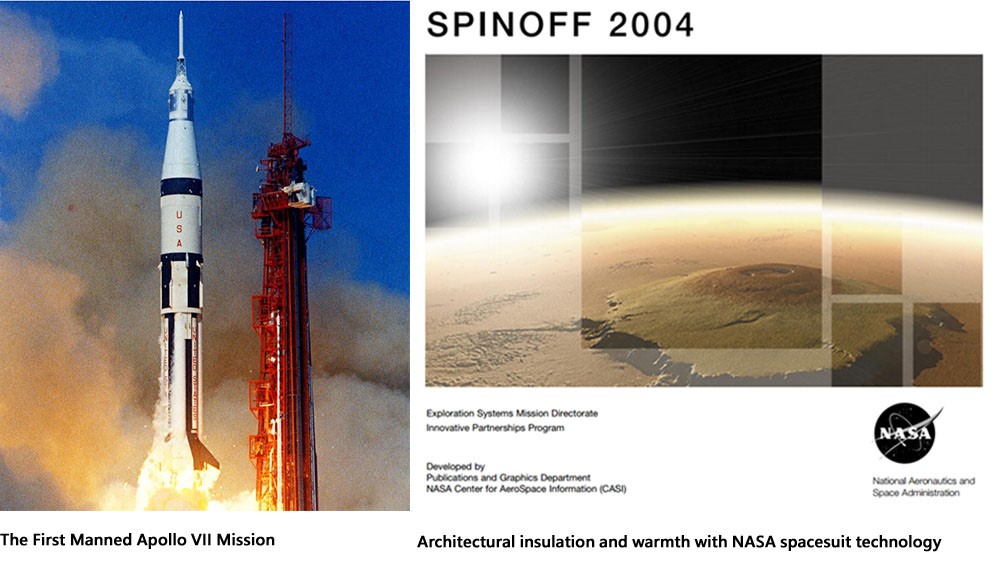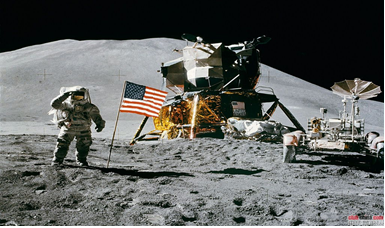
反射式輻射熱屏障技術源自 : 1976 NASA Apollo VII. Mission 美國航太總署阿波羅7號首次戴人任務
高效能的純鋁化聚合物氣泡膜斷熱技術,能讓太空人只穿著短袖就能舒適地在阿波羅號太空船內自由工作生活,這種技術也被應用在人造衛星與無人太空船的各種精密設備,確保不受外太空極溫而影響其內部運作。
反射式輻射熱屏障技術 在歐美日先進國家正被應用在建築物的斷熱領域,利用其「反射式屏障熱技術」應用在工業與農業、居家、辦公大樓等各種建築物有效地隔熱保溫,節約能源,創造舒適的環境。

Architectural insulation and warmth
ORIGINATING TECHNOLOGY / NASA CONTRIBUTION
Over 40 years ago, NASA developed Radiant Barrier technology to protect astronauts in the Apollo Program from temperatures that ranged from 250 °F above to 400 °F below zero Fahrenheit. This feat in temperature control technology enabled the astronauts to work inside the Apollo Command Module wearing short-sleeve shirts, with temperatures similar to those of a regular business office. The Radiant Barrier has been applied to virtually all spacecraft since then, including unmanned spacecraft with delicate instruments that need protection from temperature extremes. It is also applied to the astronauts’ space suits, protecting them during space walks.
Made of Aluminum Foil Polymer, the Radiant Barrier both bars and lets in heat to maintain a consistent temperature in an environment where ordinary insulation methods will not suffice. The Aluminum Foil Polymer of the material provides a reflective surface that keeps more than 95 percent of the radiated energy in space from reaching the spacecraft’s interior. In space suits, the thin and flexible material reflects the astronauts’ body heat back to them for warmth, while at the same time reflecting the sun’s radiation away from them to keep them cool.

Using conventional insulation, a space suit would have required a 7-foot-thick protective layer.
https://spinoff.nasa.gov/Spinoff2004/ch_6.html
The First Manned Apollo VII Mission
https://spinoff.nasa.gov/Spinoff2004/PDF/access.pdf
NASA〔美國太空總署〕40 多年前開發了反射輻射熱屏障技術,以保護阿波羅計畫中的太空人,免受從華氏250°F到華氏零下400°F的高低溫度差。
這溫度控制技術使太空人能夠在穿著短袖襯衫在阿波羅登月艇內自在地工作,其溫度與普通辦公室的溫度相似。從那時候開始,這種反射輻射熱屏障技術就被應用在所有的太空船上,包括那些需要隔絕極溫的載送精密儀器的無人太空船。
這種輻射隔熱屏障技術也被應用在太空人的太空裝中,讓他們在太空漫步時得到保護。
反射式隔熱技術使用純鋁化聚合物氣泡膜來隔熱.保溫,讓熱量保持一個恒定的溫度,做到了一般隔熱材料沒法達到的效果。
表面的純鋁化處理技術能反射95%以上來自太空的輻射熱量,阻擋其進入太空船內部,在太空人穿著的太空裝中,這超薄且柔軟的的材料能反射太空人的體溫回其身體達到保溫效果,也能反射來自太陽的輻射使其不至於被灼傷,以保持它們身體涼爽。
*如果使用一般傳統的體積式隔熱材料,太空裝需要7英尺〈超過2公尺〉的厚度!